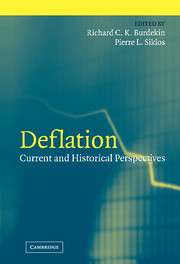Book contents
- Frontmatter
- Contents
- List of Tables and Figures
- List of Contributors
- Preface
- 1 Fears of Deflation and the Role of Monetary Policy: Some Lessons and an Overview
- PART ONE FEARS OF DEFLATION AND THE ROLE OF MONETARY POLICY
- 2 Deflation, Silent Runs, and Bank Holidays in the Great Contraction
- 3 Price Change, Financial Stability, and the British Economy, 1870–1939
- 4 Deflation Dynamics in Sweden: Perceptions, Expectations, and Adjustment During the Deflations of 1921–1923 and 1931–1933
- PART TWO DEFLATION AND ASSET PRICES
- PART THREE INTERNATIONAL PERSPECTIVES ON DEFLATION
- PART FOUR STOCK MARKET ADJUSTMENTS TO DEFLATION
- References
- Index
- Titles in the series
3 - Price Change, Financial Stability, and the British Economy, 1870–1939
Published online by Cambridge University Press: 15 December 2009
- Frontmatter
- Contents
- List of Tables and Figures
- List of Contributors
- Preface
- 1 Fears of Deflation and the Role of Monetary Policy: Some Lessons and an Overview
- PART ONE FEARS OF DEFLATION AND THE ROLE OF MONETARY POLICY
- 2 Deflation, Silent Runs, and Bank Holidays in the Great Contraction
- 3 Price Change, Financial Stability, and the British Economy, 1870–1939
- 4 Deflation Dynamics in Sweden: Perceptions, Expectations, and Adjustment During the Deflations of 1921–1923 and 1931–1933
- PART TWO DEFLATION AND ASSET PRICES
- PART THREE INTERNATIONAL PERSPECTIVES ON DEFLATION
- PART FOUR STOCK MARKET ADJUSTMENTS TO DEFLATION
- References
- Index
- Titles in the series
Summary
INTRODUCTION
For much of the last quarter-century, a principal focus of economists' attention has been inflation and, to some extent, disinflation and the associated costs. More recently, deflation has attracted some interest, although only its possible harmful consequences have been discussed; there has been no mention of deflation as the by-product of increased economic growth interacting with unchanged money growth. Concern over deflation has been prompted by some sharp rises and falls in asset prices in Japan and, more recently, in the United States and to a lesser extent the United Kingdom, and the interest taken in the relationship between these and the general price level. But also important are the actual deflations in prices in Japan, China, Hong Kong, Singapore, and Taiwan, and the near-zero inflation in the United States and Europe. But what, do we know about deflation? It is necessary to go back to before World War II to find episodes in almost any Organisation for Economic Co-Operation and Development (OECD) country except Japan. The purpose of this chapter is to begin to investigate the effects of deflation in the British economy.
The depression of the 1930s stimulated many developments in economic analysis. But Keynes's (1936) ideas on deflation in the General Theory and Irving Fisher's debt-deflation theory have been, at least by comparison, neglected. These ideas suggest that debt-deflation causes, or at least worsens, depressions. Our aim in this chapter is to explore what these ideas can contribute to understanding the behaviour of the British economy both in the late nineteenth century and in the interwar years.
- Type
- Chapter
- Information
- DeflationCurrent and Historical Perspectives, pp. 61 - 90Publisher: Cambridge University PressPrint publication year: 2004
- 5
- Cited by

